Residencia Tradicional Songso Gotaek en Cheongsong (청송 송소고택)
37.2M 2021-11-25
Songsogotaek-gil 15-2, Pacheon-myeon, Cheongsong-gun, Gyeongsangbuk-do.
+82-54-874-6556
La Residencia Tradicional Songso Gotaek se encuentra en el municipio de Cheongsong-gun, en la provincia de Gyeongsangbuk-do y data de finales de la dinastía Joseon.
Festival de la Manzana de Cheongsong (청송사과축제)
2.7Km 2025-09-09
Wolmak-ri 362, Cheongsong-eup, Cheongsong-gun, Gyeongsangbuk-do.
054-870-6237
El Festival de la Manzana de Cheongsong se celebra en octubre o noviembre de cada año para promocionar la excelente calidad de las manzanas cultivadas en el área. Cheongsong, que significa "zona limpia", tiene las condiciones perfectas para que las manzanas alcancen un sabor superior, ya que está rodeada de montañas cuya latitud promedio elevada favorece a estos árboles. Además, no hay fábricas industriales en los alrededores. El festival ofrece varios programas únicos para el entretenimiento de los visitantes y en el mercado se venden manzanas a buen precio.
Museo Folclórico de Cheongsong (청송민속박물관)
7.2Km 2022-08-05
Juwangsan-ro 222, Cheongsong-eup, Cheongsong-gun, Gyeongsangbuk-do
Situado en el Parque Nacional del Monte Juwangsan (en Cheongsong, Gyeongsangbuk-do), el Museo Folclórico de Cheongsong abrió sus puertas en 1999 para promocionar la historia y cultura del municipio y sus alrededores. El museo ofrece exhibiciones interiores y exteriores y una sala de archivos. La sala de exhibicione interior dispone de materiales educativos relacionados con la agricultura y costumbres de Cheongsong. Exhibiciones como la sala de invitados tradicional, la sala de costuras, artículos de uso diario y de porcelana de Cheongsong, ofrecen la oportunidad de conocer cómo vivía la gente en el pasado. La sala de exhibiciones exterior reproduce una taberna tradicional, una noria), un molino de piedra que usaba la fuerza del caballo o el buey, un monumento de protección y prosperidad y piedras naturales utilizadas para el culto. También hay tótems tradicionales (llamados jangseung o sotdae), que esperan a los visitantes en la entrada del museo.
Hahn by Sono (한 바이 소노)
9.7Km 2025-06-09
494, Juwangsan-ro, Cheongsong-gun, Gyeongsangbuk-do
Academia Neoconfuciana Mukgye Seowon y Residencia Mukgye del Clan Kim de Andong (묵계서원 및 안동김씨 묵계종택)
10.1Km 2024-05-17
Chunghyo-ro 1736-5, Giran-myeon, Andong-si, Gyeongsangbuk-do
Aldea de las Artes Jirye (지례예술촌)
10.6Km 2024-05-07
Jiryeyesulchon-gil 427, Imdong-myeon, Andong-si, Gyeongsangbuk-do.
La aldea se creó con la construcción de la Presa Imha de Andong. En el año 1986, el área de Jirye-ri, Imdong-myeon, de la ciudad de Andong, se encontraba en peligro de hundimiento, por lo tanto, el actual jefe de la Aldea de las Artes Jirye, Kim Won-gil, había trasladado la pequeña aldea hacia un sitio más seguro, detrás de una montaña, instalando 10 edificios. Luego en el año 1990, el Ministerio de Cultura lo había designado como la Aldea de Creatividad Artística, por lo que hasta el momento es utilizada como un espacio de entrenamiento para los trabajos de los artistas. Hay muchas presas multifuncionales construidas en el país, pero esta fue la primera que gracias a la idea de una persona, se ha podido preservar el patrimonio cultural y también establecerlo como un espacio artístico.
Posee un paisaje natural maravilloso, ya que por la noche el cielo es bordado de estrellas y hasta también pasean volando las luciérnagas. Lo único que se escucha, son los cantos de los insectos y el soplo del viento, y, por las mañanas, el lago se viste de la niebla húmeda, por lo que presenta otro escenario mágico y misterioso. El paisaje natural se viste de distintos colores, según cada estación, primavera, verano, otoño e invierno. Visitando la aldea, tendrá la posibilidad de experimentar de aquellas actividades básicas de la vida, recolectar verduras, frutas y setas de pino, cazar peces, y, también degustar de los platos típicos de la región de Andong. En particular, la otra gran experiencia, es que tendrá la oportunidad única de alojarse en la habitación con ondol (sistema de calefacción tradicional), dentro de una construcción de madera que posee 350 años de antigüedad, la que también fue declarada como material patrimonial por la provincia de Gyeongsangbuk-do. Todos los detalles de la casa, será motivo suficiente para que pueda disfrutar del ambiente.
Aunque el papel principal de la aldea es ser utilizada como un espacio de trabajo para los artistas, también es famoso para los turistas extranjeros, que lo frecuentan para conocer y experimentar la cultura coreana. El sistema de baño que utiliza la energía solar, y por la instalación de internet, ha facilitado el acceso de las mujeres y de los turistas extranjeros. Cada año es visitado por más de 5.000 personas.
Pabellón Manhyujeong (만휴정)
10.7Km 2023-02-13
Mukgyehari-gil 42, Giran-myeon, Andong-si, Gyeongsangbuk-do
Parque Nacional del Monte Juwangsan (주왕산국립공원)
11.3Km 2023-02-20
Gongwon-gil 169-7, Juwangsan-myeon, Cheongsong-gun, Gyeongsangbuk-do.
El monte Juwangsan (721 m) fue designado como el Parque Nacional N° 12 en 1976 y es el parque nacional más pequeño del pais. La montaña no es tan escarpada, lo que la hace un lugar perfecto para caminatas y disfrutar del maravilloso panorama.
Juwangsan también recibe el nombre de monte Sokbyeongsan, Jubangsan y Dedunsan. Hay una leyenda que dice que el rey de Silla (57 a.C-935 d.C) vivió en esta montaña después de entregar su trono a Goryeo. De aquí proviene su nombre “Juwang” ("donde reside el rey", en coreano). Existe otra leyenda en la cual se dice que el general Mailseong de Goryeo asesinó con flechas y armas de hierro, al rey Wuju quien estaba viviendo aquí.
En el monte Juwangsan hay templos como los templos Daejeonsa, Gwangamsa, Yeonhwasa y ermitas como el Juwangam y Baekryeonam. En el templo Daejeonsa se preservan tesoros nacionales como el retrato del gran monje budista Sa-Myeong, y la tabla de madera tallada por el mismo general Lee Yeo-Song para el monje Sa-Myeong. También podrá encontrar muchas rocas con interesantes formaciones como el Giam, Seokbyeokam, Geupsudae, Jeongsam y Adeulbawi; asimismo, cuevas como Juwanggul donde Juwang se escondía, pero que finalmente fue atrapado; el Mujanggul, donde se almacenaban las armas; y Yeonhwagul donde se hacían los entrenamientos.
Hay muchas cascadas que muestran la belleza del monte Juwangsan. Las principales son las cascadas 1era., 2da., 3era., y las cascadas Dalgi. También se pueden encontrar hermosos valles como el valle Juwang-externo, Juwang-interno, Wolwae y Naewon. En la ladera de la montaña hay un Jahaseong de 6 metros de alto que se extiende unos 15 km., y en el arroyo Goenae se encuentra la fuente de agua mineral Dalgimul.
Templo Daejeonsa (대전사)
11.5Km 2023-02-22
Gongwon-gil 226, Juwangsan-myeon, Cheongsong-gun, Gyeongsangbuk-do.
Se dice que este templo fue construido por el Gran Monje Uisang en el 12º año del reinado del rey Munmu (año 672). Fue reconstruido en el 13º año del reinado del rey Hyeonjong (año 1672) después de que un fuego lo destruyera en la Guerra de Imjin contra la invasión japonesa. Durante el trabajo de renovación de la sala Bogwangjeon en 1976, se encontró un texto que se había puesto entre las vigas. La sala Bogwangjeon es un pequeño edificio y su techo tiene la forma del símbolo #. En la sala hay una estatua budista Birojanabul consagrada.
Suaedang / 안동 수애당
15.9Km 2025-08-12
1714-11, Sugogyonggye-ro Imdong-myeon, Andong-si, Gyeongsangbuk-do
+82-54-822-6661
'Suaedang Traditional House was built by Ryu Jin-geol, also known by his pen-name of Suae, in 1939. This hanok-style house consists of three buildings that measure 29-kan (a traditional measurement that corresponds to the space between two columns) in total.
The main room, or jeongchim (7-kan at front and 2-kan at sides), has a half-hipped roof, and forms a‘ㄱ’-shape with the storeroom (10-kan at front), which also has a half-hipped roof. Originally located at 612 Sugok-dong, Andong-si, the house was relocated from a slight slope to a flat piece of land due to the construction of Imha Dam in 1987. Consequently, the Jeongchim was rebuilt at a lower level than before.
The Suaedang was renovated by modernizing the old-style facilities including the kitchen, toilets, and washroom without changing their external features, while the rooms and daecheongmaru (main floored room) were decorated with red clay and natural paint. Suaedang, with its beautiful panoramic view of the lake, was designated as Gyeongsangbuk-do Cultural Property No. 56.
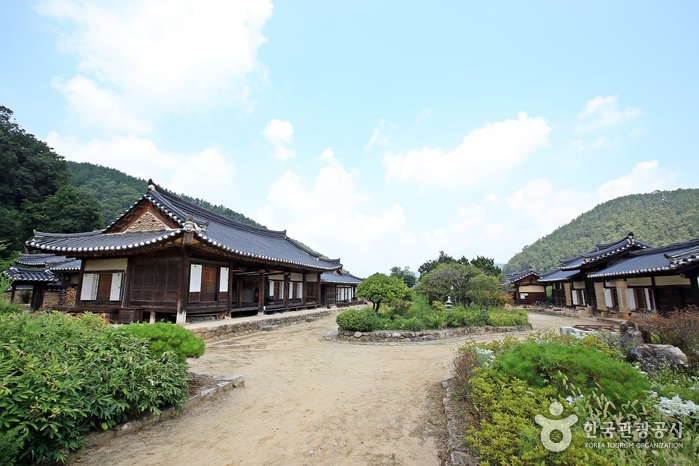
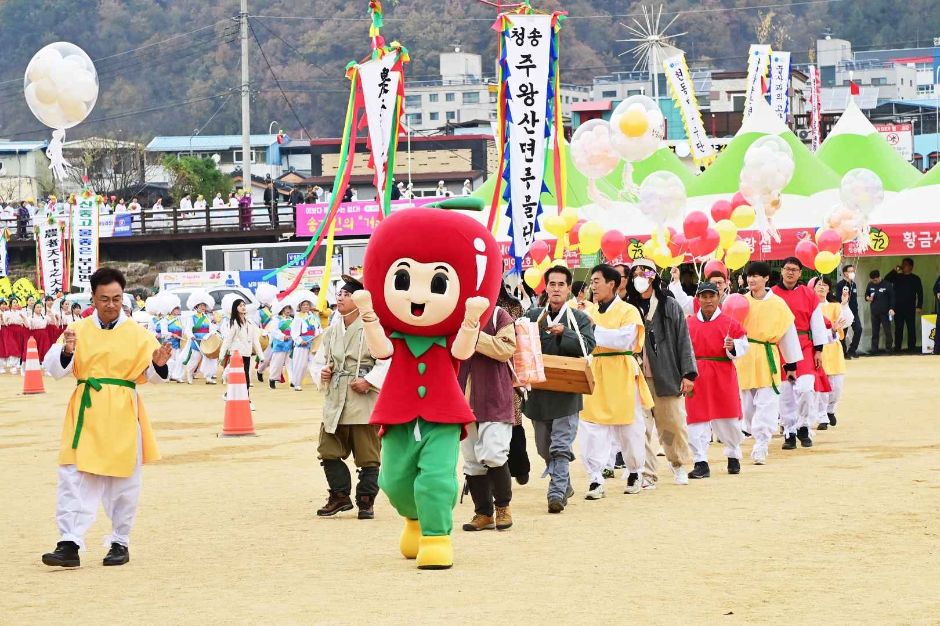
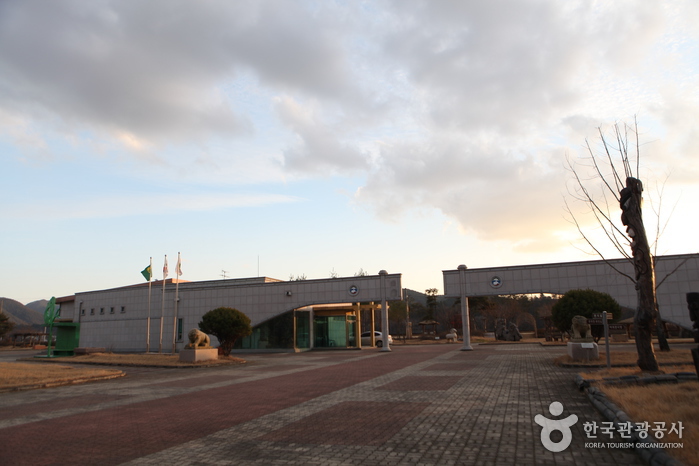
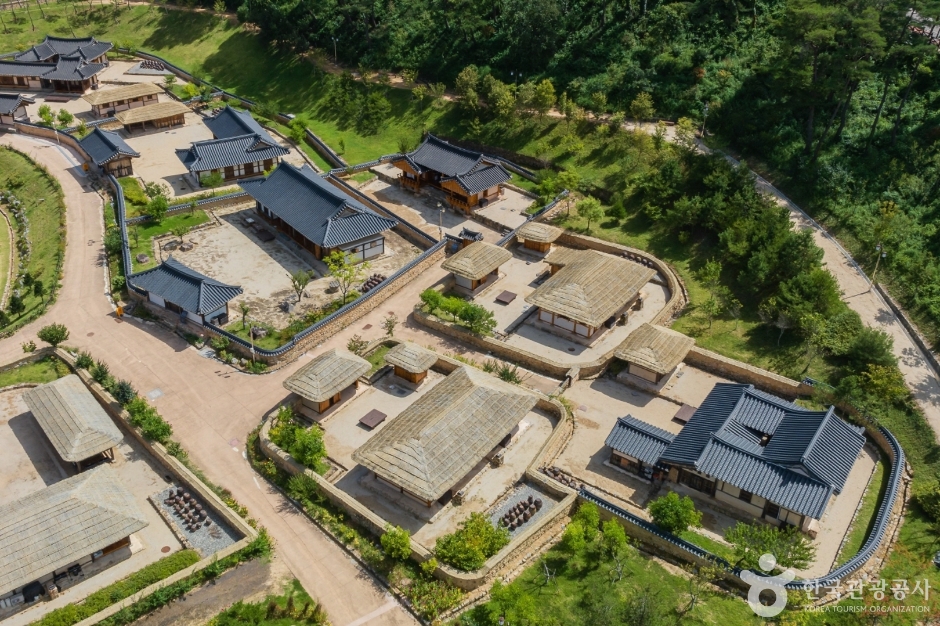
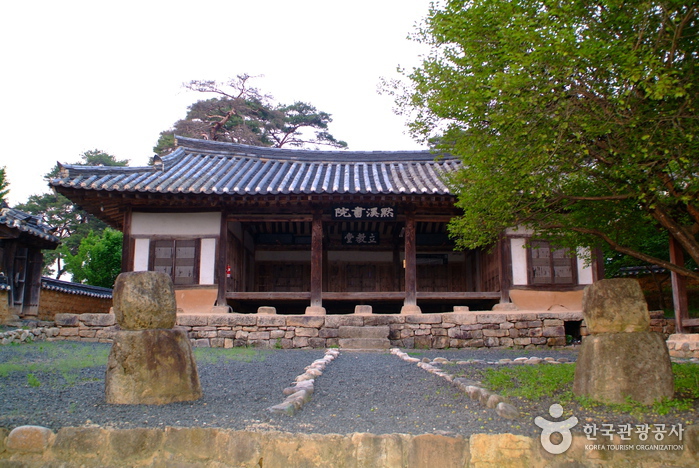
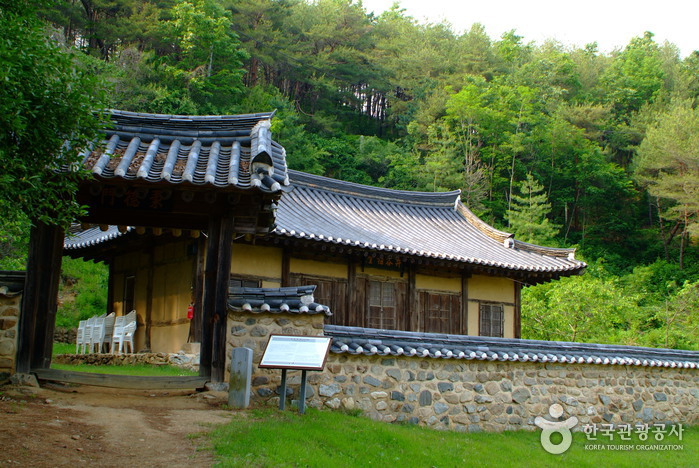

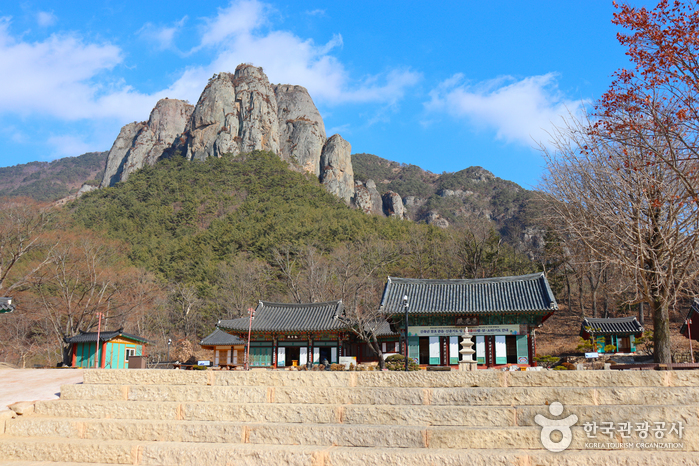
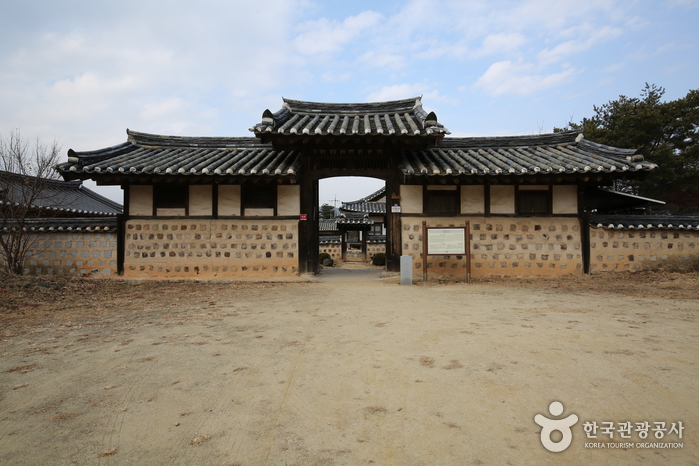
 Español
Español
 한국어
한국어 English
English 日本語
日本語 中文(简体)
中文(简体) Deutsch
Deutsch Français
Français Русский
Русский